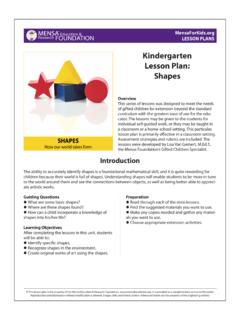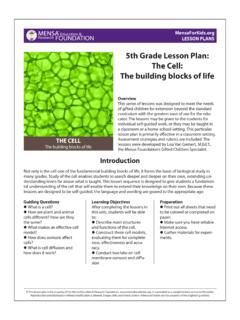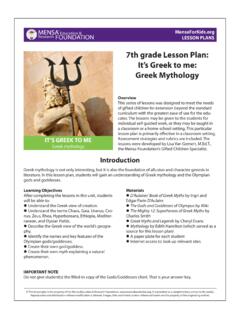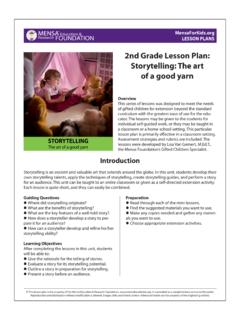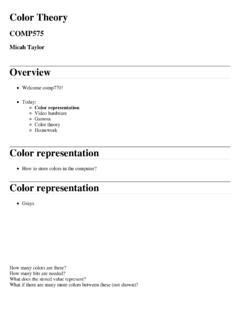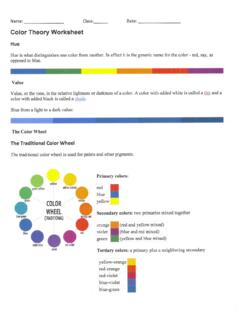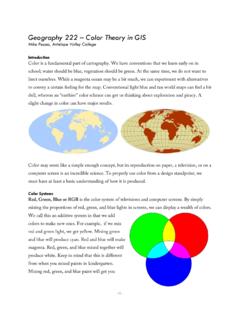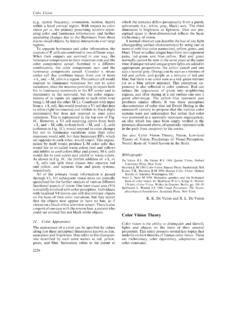Transcription of Introduction to Color: The Foundation of Art and Design
1 Introduction to color : The Foundation of Art and Design Overview This series of lessons was designed to meet the needs of gifted children for extension beyond the standard curriculum with the greatest ease of use for the edu- cator. The lessons may be given to the students for individual self-guided work, or they may be taught in a classroom or a home-school setting. This particular lesson plan is primarily effective in a classroom setting. Assessment strategies and rubrics are included. The lessons were developed by Lisa Van Gemert, , the Mensa Foundation 's Gifted Children Specialist.
2 Introduction color and color theory form the Foundation of art as well as Design . Gifted children are often tuned in to the aesthetic nature of things at an early age and can appreciate the nuances of color , as well as the way colors are blended, tinted and shaded. GUIDING QUESTIONS LEARNING OBJECTIVES. What is color ? How do we represent and create After completing this project, students will be able color ? to: l Identify color terms using the academic vocabu- lary of the discipline l Recognize the use of primary and secondary colors l Evaluate the use of color in fine art painting l Create a reverse color scheme of a painting l Design an eye spy activity for a painting, fo- cused on the use of color l Conduct independent research on color and analyze that research This lesson plan is the property of the Mensa Education & Research Foundation , It is provided as a complimentary service to the public.
3 Reproduction and distribution without modification is allowed. Images, links and linked content referenced herein are the property of the originating entities. Lesson 1: Introduction to color Look at this picture. What colors do you see? List the three colors you think are most easily visible in this painting. 1. _____. 2. _____. 3. _____. Sunflowers (1887), by Van Gogh How about this one? What colors do you see here? List the three colors you think the artist used most in this painting. 1. _____. 2. _____. 3.
4 _____. Jardin Sainte-Adresse (1866-67), by Monet This lesson plan is the property of the Mensa Education & Research Foundation , It is provided as a complimentary service to the public. Reproduction and distribution without modification is allowed. Images, links and linked content referenced herein are the property of the originating entities. 2 | Mensa Foundation Lesson Plan: color . 3. things to know about color : l color is a way that we describe an object based on the way that it reflects or emits light. l Your eye can see different colors because a part of your eye called the retina is sensitive to differ- ent wavelengths of light.
5 L Humans are what is called trichromats, meaning our retinas have three different kinds of cells that can receive color . Those cells are called cones. What is your favorite color ? Dogs are _____. dichromats, What do you think the most meaning that common favorite color in the world is? (See the bottom of the they can only page to find the answer.). see two _____ different kinds of color . To organize colors and show their relationship to each other, we use a color wheel. This shows the colors and how they are related to each other.
6 On a traditional color wheel, three colors are called primary colors. From these three colors, all of the colors on the color wheel can be made. The three primary colors on the traditional color wheel are red, yellow and blue. Can you find the primary colors on this color wheel? (Blue is the most popular color in the world.). This lesson plan is the property of the Mensa Education & Research Foundation , It is provided as a complimentary service to the public. Reproduction and distribution without modification is allowed.
7 Images, links and linked content referenced herein are the property of the originating entities. Mensa Foundation Lesson Plan: color | 3. Lesson 2: The language of color Like many disciplines, color has its own vocabulary. Watch the video at for an Introduction to the language of color . Next, take this pre-assessment to see how much you already know about color 's words. color Vocabulary Pre-Assessment The chart that shows the relationship of different colors to each other is called the (1) _____. Instead of the word color , one could also use the three-letter word (2) _____.
8 The three colors from which all other colors are made are called (3)_____ colors, and they are (4)_____, _____, and _____. Colors that are created by mixing equal parts of the colors above are called (5) _____ colors, and they are (6) _____, _____, and _____. Colors that are created from equal parts of each of the two kinds of colors above are called intermediate or (7)_____ colors. When describing these colors, place the (8). _____ color first. Colors that are next to each other on the color wheel are called (9)_____.
9 Colors that are oppo- site to each other on the color wheel are called 10)_____. When these colors are placed next to each other, they make each other seem (11) _____. When mixed equally, they create muddy tones like black, gray, and brown. If you add white to a color , that is called a (12) _____. If you add black to a color , that is called (13)_____. If something only uses one color , it is called (14)_____. If something uses more than one color , it is called (15) _____. If something is completely lacking in color , it is called (16)_____.
10 The colors on the green/blue/violet side of the color wheel are called (17) _____. The colors on the red/orange/yellow side of the color wheel are called (18) _____. When completed, check your answers. If you got at least 14 of the 18 correct, move on to Lesson 3 below. If you didn't, read more about it at before you move on. This lesson plan is the property of the Mensa Education & Research Foundation , It is provided as a complimentary service to the public. Reproduction and distribution without modification is allowed.
